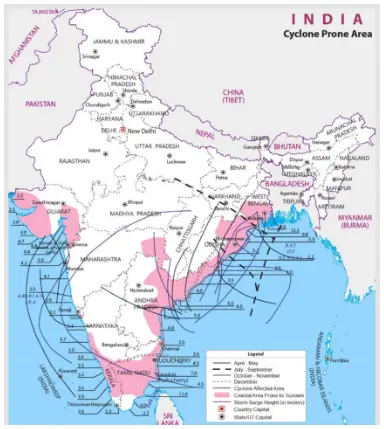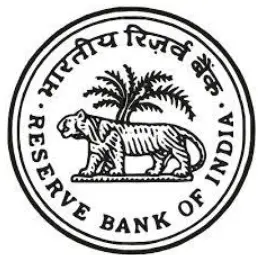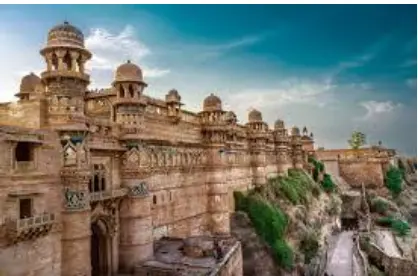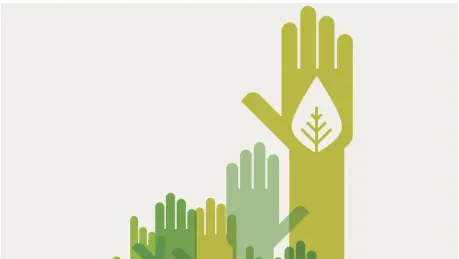Friday, 5th April 2024
Concerns About The Global Biodiversity Framework
In News: At a recent symposium hosted by the University of Arizona, attention was drawn to the apprehensions surrounding the Kunming-Montreal Global Biodiversity Framework (GBF) and its potential ramifications, with a particular focus on the impact it may have on the indigenous tribes of India.
Implications of Forest Expansion on India's Indigenous Tribes
- Restriction of Traditional Land Use Practices
- Forest expansion may limit the traditional land use practices of indigenous communities, affecting their livelihoods and leading to increased poverty and food insecurity.
- Threat to Indigenous Existence
- Expansion of protected areas may pose a threat to the existence of indigenous populations, as a significant percentage of national parks are established in areas inhabited by indigenous peoples.
- Displacement of Tribal Villages
- Initiatives such as upgrading wildlife sanctuaries to tiger reserves or expanding existing sanctuaries may lead to the displacement of tribal villages, affecting indigenous communities' rights and heritage.
Utilizing Indigenous Tribes in Biodiversity Conservation
- Preserving Cultural Heritage through Ecotourism
- Support ecotourism initiatives led by indigenous communities to preserve cultural heritage, generate income, and safeguard wildlife.
- Integrating Traditional Knowledge
- Leverage traditional knowledge of indigenous tribes for biodiversity conservation by integrating it with scientific surveys and conservation plans.
- Promoting Co-Management Models
- Expand co-management models where indigenous communities work alongside forest departments to manage protected areas, fostering a sense of ownership and leveraging indigenous knowledge.
Strategies for the Way Forward
- Free, Prior, and Informed Consent (FPIC)
- Uphold FPIC as a mandatory requirement before establishing protected areas on tribal lands, ensuring indigenous communities have a say in conservation efforts.
- Social Impact Assessment
- Conduct social impact assessments to understand the potential effects of protected area expansion on existing livelihoods, aligning policies with international standards and principles.
- Alignment with International Standards
- Align national policies with UNDRIP principles, respecting indigenous rights and knowledge systems while implementing conservation efforts.
|
UPSC Previous Year Questions Prelims (2018) Q. “Momentum for Change: Climate Neutral Now” is an initiative launched by (a) The Intergovernmental Panel on Climate Change Ans: (c) |
Source: TH
India rejects China’s senseless Arunachal act
In News: India has vehemently rejected China's renaming of certain places in Arunachal Pradesh, dismissing the move as senseless. It emphasized that the act of assigning invented names does not change the reality that Arunachal Pradesh "is, has been, and will always be" an integral part of India.
Understanding the McMahon Line and China's Claims in Arunachal Pradesh
- Origin of the McMahon Line
- The McMahon Line is a disputed boundary in the Eastern Sector of the India-China border, drawn during the Shimla Conference in 1913-14 by Sir Henry McMahon, the then foreign secretary of British India.
- Dispute Over the McMahon Line
- China refuses to recognize the McMahon Line, claiming it as "illegal" and asserts territorial claims over areas in Arunachal Pradesh, which it considers part of Southern Tibet.
- Indo-China War of 1962
- The disputed area, particularly Arunachal Pradesh, witnessed conflict during the 1962 war. While China occupied the region temporarily, it withdrew respecting the McMahon Line after a unilateral ceasefire.
China's Renaming of Places in Arunachal Pradesh
- Release of Standardized Geographical Names
- China periodically releases lists of standardized geographical names for places in Arunachal Pradesh. Recently, in March 2024, the fourth list was released.
- Purpose of Renaming
- China's renaming efforts are part of its strategy to assert territorial claims over Indian territory, portraying Arunachal Pradesh as part of China's territory known as Zangnan or "South Tibet."
- Strategic Assertion
- Beijing's renaming efforts coincide with Indian dignitaries' visits to Arunachal Pradesh and serve as a means to assert its sovereignty claim over the region.
China's Territorial Strategy
- Historical and Cultural Basis
- China justifies its claims based on historical and cultural ties, asserting that the names used in Southern Tibet reflect its sovereignty over the region.
- Foreign Policy Tactics
- Beijing's aggressive claims over territories, such as Taiwan and disputed islands in the South China Sea, demonstrate its broader foreign policy tactics aimed at altering territorial realities.
- Consistent Efforts
- China continues to make consistent efforts to change facts on the ground in disputed regions, utilizing historical claims and cultural ties to assert sovereignty.
Source: IE
Report on Solar Waste Management
In News: A recent report titled 'Facilitating a Circular Economy in India's Solar Sector - Evaluating the Quantity of Solar Waste' has brought attention to the growing challenge of solar waste in India.
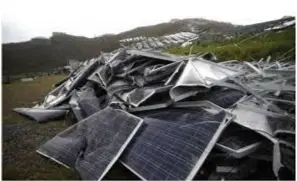
Key Highlights of the Report on Solar Waste Management
- Solar Waste Projection
- India's current solar capacity has generated approximately 100 kilotonnes (kt) of cumulative waste as of FY23, projected to increase to 340 kt by 2030 and 19,000 kt by 2050.
- Majority of the waste generated by 2050 (77%) will stem from new capacities.
- State-wise Contribution
- Five states—Rajasthan, Gujarat, Karnataka, Tamil Nadu, and Andhra Pradesh—are projected to account for around 67% of the solar waste by 2030.
- Rajasthan is expected to contribute 24% of the waste by 2030, followed by Gujarat (16%) and Karnataka (12%).
- Critical Minerals Content
- Discarded solar modules contain critical minerals crucial for India's economic development and national security, including silicon, copper, tellurium, and cadmium.
- By 2030, the projected waste is estimated to contain 10 kt of silicon, 12-18 tonnes of silver, and 16 tonnes of cadmium and tellurium.
Recommendations for Effective Solar Waste Management
- Database Maintenance by MNRE
- The Ministry of New and Renewable Energy (MNRE) should maintain and update a database of installed solar capacity for accurate mapping of potential waste generation centers.
- Guidelines Issuance by MoEFCC
- The Ministry of Environment, Forest and Climate Change (MoEFCC) should issue guidelines for collecting, storing, and processing solar waste to ensure safe and efficient management.
- Responsibility Assignment to Producers
- Solar cell and module producers should develop waste collection and storage centers as per their responsibilities outlined in the Electronic Waste Management Rules 2022.
Understanding Solar Waste and Its Management
- Definition and Composition
- Solar waste encompasses waste generated during solar module manufacturing and discarded modules.
- It contains materials like silicon, glass, aluminium, and hazardous substances such as lead and cadmium.
- Recycling Potential
- Approximately 80% of solar panel components are recyclable, including glass and metal frames.
- Recycling processes can recover materials like glass, aluminium, copper, silicon, and silver.
- Challenges in India
- Lack of comprehensive policy framework and standardised recycling practices.
- Complex composition of solar panels and difficulty in separating components.
- Involvement of informal recyclers and limited market demand for recycled materials.
Strategies for Effective Solar Waste Management in India
- Regulatory Framework Strengthening
- Establish a comprehensive regulatory framework with specific recycling targets and incentives to promote recycling and material recovery.
- Formalization of Informal Sector
- Integrate informal recyclers into the formal system through training and providing equipment for safe and environmentally sound practices.
- Promotion of Circular Economy
- Develop and implement policies to promote circular economy principles within the solar industry, encouraging resource efficiency and reuse.
Understanding Electronic Waste Management Rules 2022
- Overview
- Governed under the Environment Protection Act, 1986, these rules regulate the management of electronic waste (e-waste), including solar PV modules, panels, and cells.
- Key Features
- Extended Producer Responsibility (EPR) mandates specific recycling targets for producers.
- Producers are required to store solar e-waste up to 2034-2035 and file annual returns on the e-waste management portal.
- Regulations on hazardous substances and exceptions for specific waste categories are outlined.
|
UPSC Previous Year Questions Prelims (2016) Q. Consider the following statements:
Which of the statements given above is/are correct? (a) 1 only Ans: (a) Mains (2020) Q. India has immense potential of solar energy though there are regional variations in its developments. Elaborate. |
Source: IE
UP Board of Madarsa Education Act, 2004
In News: The Allahabad High Court (HC) has ruled the Uttar Pradesh Board of Madarsa Education Act, 2004, as unconstitutional.

Overview of the Uttar Pradesh Board of Madarsa Education Act, 2004
- Regulation of Madrasas
- The Act aimed to regulate and govern the functioning of madrasas (Islamic educational institutions) in the state of Uttar Pradesh.
- Establishment of Framework
- It provided a framework for the establishment, recognition, curriculum, and administration of madrasas across Uttar Pradesh.
- Creation of Governing Body
- Under this Act, the Uttar Pradesh Board of Madarsa Education was established to oversee and supervise the activities of madrasas in the state.
Constitutional Provisions Related to Education
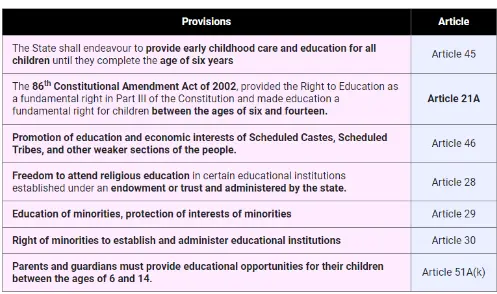
Concerns Regarding the Act
- Constitutional Violation
- The Act has been deemed unconstitutional by the Allahabad High Court for promoting education segregated along religious lines, conflicting with secular principles enshrined in the Indian Constitution and fundamental rights.
- Provisions of the Act were criticized for failing to ensure quality compulsory education up to the age of 14 years as mandated by Article 21 A of the Constitution.
- Concerns were raised regarding the exclusion of madrasas from the Right to Education (RTE) Act, 2009, potentially depriving students of universal and quality school education.
- Limited Curriculum
- The court noted a heavily Islamic-focused curriculum in madrasas, with minimal emphasis on modern subjects.
- Students were required to prioritize the study of Islam and its doctrines, with modern subjects often offered as optional or minimally included.
- Conflict with Higher Education Standards
- The Act conflicted with Section 22 of the University Grants Commission (UGC) Act, 1956, raising questions about its compatibility with higher education standards.
High Court Ruling
- Declaration of Unconstitutionality
- The Allahabad High Court declared the Uttar Pradesh Board of Madarsa Education Act, 2004 unconstitutional due to violations of secular principles and fundamental rights.
- It directed the state government to accommodate madrasa students in recognized regular schools and raised concerns about the limited curriculum focused on Islamic studies.
- The ruling highlighted potential adverse effects on students' access to quality education and prompted legal arguments regarding constitutional violations.
|
UPSC Previous Year Questions Prelims (2012) Q. Which of the following provisions of the Constitution does India have a bearing on Education?
Select the correct answer using the codes given below: (a) 1 and 2 only Ans- (d) Mains (2020) Q1. How have digital initiatives in India contributed to the functioning of the education system in the country? Elaborate on your answer. Mains (2021) Q2. Discuss the main objectives of Population Education and point out the measures to achieve them in India in detail. |
Source: IE
Ring of Fire
In News: Due to its location along the Pacific "Ring of Fire," Taiwan is susceptible to earthquakes, as this area accounts for 90% of global seismic activity.

About the Ring of Fire
- It constitutes a series of hundreds of volcanoes and earthquake-prone areas bordering the Pacific Ocean.
- Shaped like a semicircle or horseshoe, it spans approximately 40,250 kilometers.
- The Ring of Fire marks the convergence zones of multiple tectonic plates, including the Eurasian, North American, Juan de Fuca, Cocos, Caribbean, Nazca, Antarctic, Indian, Australian, Philippine, and other smaller plates, encircling the vast Pacific Plate.
- It traverses through 15 countries, including the USA, Indonesia, Mexico, Japan, Canada, Guatemala, Russia, Chile, Peru, and the Philippines.
Factors Making it Prone to Earthquakes
- Earthquakes are frequent in the Ring of Fire due to the continuous movement, collision, and sliding past of tectonic plates.
- The rough edges of these plates often get stuck against each other while the remainder of the plate continues to move.
- Earthquakes occur when the stuck edges suddenly release along faults after sufficient plate movement.
Volcanic Activity in the Ring of Fire
- The Ring of Fire hosts numerous volcanoes, primarily due to tectonic plate movements.
- Many volcanoes in this region are formed through subduction, a process where one tectonic plate is forced beneath another, creating deep trenches.
- Most of the world's subduction zones, leading to volcanic activity, are situated within the Ring of Fire.
Source: IE
Marine Products Export Development Authority
In News: Officials recently confirmed that the Marine Products Export Development Authority (MPEDA) certifies the entire value chain of India's shrimp exports, ensuring that there are no possibilities for abusive conditions at shrimp farms.
About the Marine Products Export Development Authority (MPEDA)
- MPEDA is a statutory body mandated with the primary responsibility of promoting the export of marine products.
History
- Established through an act of Parliament in 1972, MPEDA merged with the former Marine Products Export Promotion Council, which was founded by the Government of India in September 1961.
Functions
- Development and regulation of offshore and deep-sea fishing, along with conservation and management measures for offshore and deep-sea fisheries.
- Registration of fishing vessels, processing plants, storage premises for marine products, and conveyances used for marine product transportation.
- Establishment of standards and specifications for marine products intended for export.
- Regulation of marine product exports and registration of marine product exporters upon payment of prescribed fees.
- Operation of five full-fledged Quality Control Laboratories located in Kochi, Nellore, Bhimavaram, Bhubaneshwar, and Porbandar.
- Establishment of fifteen ELISA Screening Laboratories across maritime states.
- Establishment of 18 Regional/Sub-Regional Divisions/Desk Offices to facilitate outreach to exporters across the country.
Headquarters
- Located in Kochi, Kerala.
Trade Promotion Offices
- Operates trade promotion offices in New Delhi, Tokyo, and New York.
Nodal Ministry
- MPEDA operates under the purview of the Ministry of Commerce and Industry.
Source: TH
Sainik Schools
In News: The Defence Ministry recently affirmed that the scheme for establishing new Sainik Schools is thoroughly planned, and the selection process is not influenced by the political or ideological affiliation of the applicant institution.
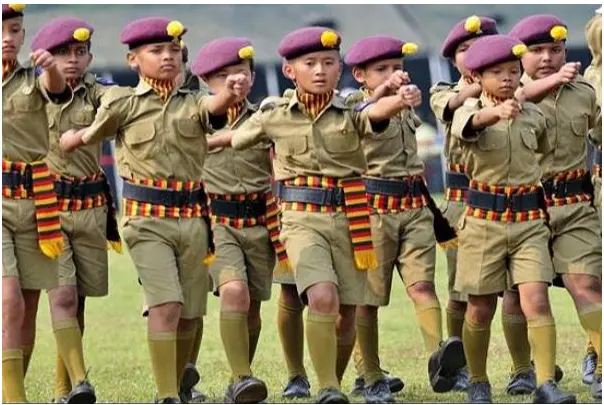
Overview of Sainik Schools
- Sainik Schools are residential institutions providing Public School Education affiliated with the Central Board of Secondary Education (CBSE), New Delhi.
- Funding for these schools comes from both Central and State governments.
- The scheme to establish Sainik Schools was initiated in 1961 with the primary objective of preparing students academically, physically, and mentally for entry into the National Defence Academy.
- These schools operate under the governance of the Sainik Schools Society, registered under the Societies Registration Act XXI of 1860, Ministry of Defence. Their goal remains focused on preparing boys for entry into the National Defence Academy.
- Presently, there are 33 Sainik Schools situated across various regions of the country. From the academic session 2021-22, girls cadets have also been admitted to Sainik Schools.
- Recent Initiative: The Government of India has approved a plan to establish 100 new Sainik Schools under the Sainik Schools Society, Ministry of Defence, in collaboration with NGOs/Private Schools and State Governments. The objective is to cultivate a youth community with strong academic, cultural, and leadership qualities, prioritizing the nation's interests.
Source: TH
PRATUSH Telescope
In News: Astronomers are anticipating the opportunity to unveil a new perspective on the universe by deploying high-resolution telescopes on the moon and in orbit around it. This includes PRATUSH, a telescope from India, which is expected to contribute to this endeavor.
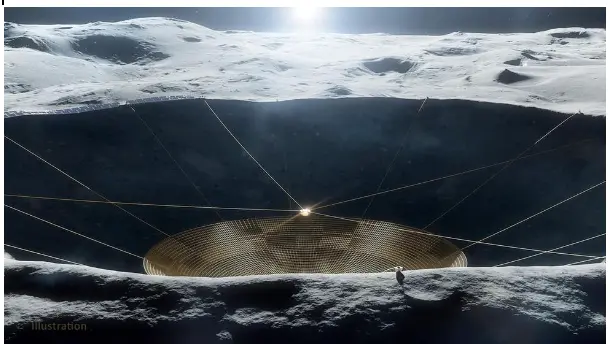
About PRATUSH Telescope
- Purpose: PRATUSH (Probing ReionizATion of the Universe using Signal from Hydrogen) is a radio telescope designed to be situated on the moon's far side.
- Development: The telescope is being constructed by the Raman Research Institute (RRI) in Bengaluru, with active collaboration from the Indian Space Research Organisation (ISRO).
- Deployment: Initially, ISRO will position PRATUSH into orbit around the Earth. Following adjustments and fine-tuning, the space agency will subsequently launch it towards the moon.
- Main Roles: PRATUSH aims to detect signals emitted by the first stars and galaxies, unveiling the cosmic dawn of the universe. It seeks to address questions regarding the timing of the first stars' formation, the characteristics of these early stars, and the nature of the light they emitted.
- Equipment: The telescope will be equipped with a wideband frequency-independent antenna, a self-calibrating analog receiver, and a digital correlator. These instruments are designed to capture radio noise within the crucial signal originating from the Dark Ages.
- Sensitivity: PRATUSH is targeted to achieve instrument sensitivity at the level of a few millikelvin, without being constrained by any systematic features.
Source: TH
Nitrogen-Fixing Bacteria
In News: Recently, scientists have identified symbiotic organisms capable of nitrogen fixation that display behaviors akin to organelles.
About Nitrogen-Fixing Bacteria
- Definition: Nitrogen-fixing bacteria are prokaryotic microorganisms capable of converting nitrogen gas from the atmosphere into "fixed nitrogen" compounds like ammonia, which are essential for plant growth.
- Types
- Symbiotic or Mutualistic: These bacteria reside in the root nodules of specific plants, notably legumes, forming a mutualistic relationship.
- Examples: Rhizobium associated with pea plants, and various Azospirillum species linked with cereal grasses.
- Free-Living: These bacteria exist independently and do not rely on a host. They are commonly found in soil or aquatic environments.
- Examples: Cyanobacteria like Anabaena and Nostoc, and genera such as Azotobacter, Beijerinckia, and Clostridium.
- Significance
- Essential Nutrient: Nitrogen is a crucial component of proteins and nucleic acids, vital for all life forms.
- Role in Nitrogen Cycle: Nitrogen-fixing bacteria facilitate over 90 percent of nitrogen fixation, contributing significantly to the nitrogen cycle and ecosystem functioning.
Source: PO
Indian Laurel Tree
In News: Recently, officials from the forest department in Andhra Pradesh's Alluri Sitharama Raju district made an incision in the bark of an Indian laurel tree, resulting in a sudden gush of water.
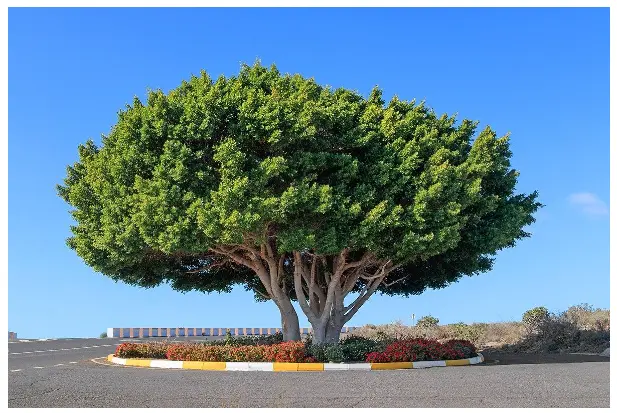
About Indian Laurel Tree
- Scientific Name: Terminalia elliptica (syn. T. tomentosa)
- Other Names: Asna; saj or saaj; Indian laurel; marutham (Tamil); matti (Kannada); ain (Marathi); taukkyan (Burma); asana (Sri Lanka); and colloquially crocodile bark due to its characteristic bark pattern.
- Habitat: Primarily found in both dry and moist deciduous forests in southern India up to 1000 m.
- Distribution: Native to southern and Southeast Asia, including India, Nepal, Bangladesh, Myanmar, Thailand, Laos, Cambodia, and Vietnam.
Applications
- The wood is utilized for various purposes such as furniture, cabinetwork, joinery, paneling, specialty items, boat-building, railroad cross-ties (treated), decorative veneers, and in the construction of musical instruments like guitar fretboards.
- Its leaves serve as a food source for Antheraea paphia (silkworms), which produce tussar silk (Tussah), a commercially significant form of wild silk.
- Medically, the bark is used to treat diarrhea, and oxalic acid can be extracted from it.
- Both the bark and fruit yield pyrogallol and catechol, substances used for dyeing and tanning leather.
Source: IT
West Against the Rest
In News: A recent article delves into NATO's 75th anniversary and its function as a mechanism for preserving Western dominance via its military prowess, alongside other notable facets concerning the alliance.
Overview of NATO (North Atlantic Treaty Organization)
About
- NATO is an intergovernmental military alliance formed in 1949 with the primary objective of providing collective defense against potential aggression, particularly from the Soviet Union during the Cold War era.
- Over time, NATO has adapted to address various security challenges beyond its original mandate.
History
- Formation: Established on April 4, 1949, with the signing of the North Atlantic Treaty in Washington, D.C., by 12 founding member countries from Europe and North America.
- Cold War Era: Served as a deterrent against Soviet expansionism, with significant military support from the US to European allies.
- Post-Cold War: Expanded focus to include crisis management, conflict prevention, and cooperative security efforts.
Membership
- Original Members: Belgium, Canada, Denmark, France, Iceland, Italy, Luxembourg, the Netherlands, Norway, Portugal, the United Kingdom, and the United States.
- Expansion: Currently consists of 32 member countries, with new members joining in multiple rounds.
Concerns Related to NATO’s Functioning
- Unrestrained Offensive
- NATO's involvement in over 200 military conflicts worldwide, including 20 major ones, raises concerns about its offensive actions.
- Misadventures in Eastern European, Middle East, and Asian Countries
- Involvement in conflicts such as the bombing of Yugoslavia, invasion of Iraq, and military interventions in Syria and Afghanistan.
- Provoking Russia-Ukraine War
- NATO's expansion and transformation of Ukraine into a strategic point against Russia are seen as provocations.
- Maintaining Western Hegemony
- NATO's military potential is viewed as a tool to maintain Western hegemony, perpetuating colonial practices under the guise of democracy and human rights.
- Unwarranted Expansion
- Expansion of NATO's capabilities in outer and cyberspace, along with aggressive behavior beyond Russia, raises concerns.
- Capitalizing on Threat in The Indo-Pacific
- Attempts to extend responsibility over the Indo-Pacific region through alliances like AUKUS and US-Japan-South Korea troika are seen as expansionist.
Successes And Failures of NATO Grouping
- Successes
- Cold War: Contributed to controlling the Soviet Union, dissuading militant nationalism, and maintaining peace during the Cold War.
- Modern Day Protection: Continues to provide collective security and crisis management support globally, including humanitarian aid efforts.
- Humanitarian Aid to Ukraine: Public denouncement of Russian invasion and significant aid contributions to Ukraine.
- Failures
- Funding Issues: Majority of NATO members do not meet defense spending commitments.
- Afghanistan: Withdrawal of NATO forces led to the collapse of the Afghan government.
- Right-Wing Nationalism: Rising discontent with international institutions like NATO.
- Russian Aggression: NATO's expansion perceived as a threat by Russia, contributing to tensions in the region.
Reforms Required to Make NATO More Effective and Efficient
- Quality, Coherence, and Timeliness of Advice
- Enhance the importance and functions of the five main policy committees within NATO.
- Improve coordination among these committees to align agendas with the Council's priorities for effective and timely advice.
- NATO’s Non-Military Dimension
- Ensure engagement benefits from civil expertise at the political level and capacity on the ground.
- Consider creating a civil security committee or analogous structure to facilitate non-military operations.
- Organisational Cohesion and Internal Synergy
- Streamline NATO bodies to deliver against strategic-level priorities, enhancing transparency and commonality of purpose.
- An Inclusive and United Alliance
- Mirror institutional arrangements to reinforce allied unity and foster a shared sense of purpose.
- Encourage political dialogue, consultation, and cooperation with non-NATO nations.
- The Alliance Must Remain Distinct
- Actively integrate with other international organizations while maintaining NATO's core strength in combining robust military capabilities with nuanced strategies.
- Focus on Non-Traditional Threats
- Adapt to address non-traditional threats such as terrorism, cyber attacks, disinformation campaigns, and supply chain security.
Conclusion
As NATO approaches its 75th anniversary, it faces a changing global security landscape. To remain effective, NATO must adapt and reform by investing in defense capabilities, improving decision-making processes, and broadening its focus to address emerging threats such as cyber warfare and technological superiority.
Source: IE
Share the article
Edukemy’s Current Affairs Quiz is published with multiple choice questions for UPSC exams
MCQ
Get Latest Updates on Offers, Event dates, and free Mentorship sessions.

Get in touch with our Expert Academic Counsellors 👋
FAQs
UPSC Daily Current Affairs focuses on learning current events on a daily basis. An aspirant needs to study regular and updated information about current events, news, and relevant topics that are important for UPSC aspirants. It covers national and international affairs, government policies, socio-economic issues, science and technology advancements, and more.
UPSC Daily Current Affairs provides aspirants with a concise and comprehensive overview of the latest happenings and developments across various fields. It helps aspirants stay updated with current affairs and provides them with valuable insights and analysis, which are essential for answering questions in the UPSC examinations. It enhances their knowledge, analytical skills, and ability to connect current affairs with the UPSC syllabus.
UPSC Daily Current Affairs covers a wide range of topics, including politics, economics, science and technology, environment, social issues, governance, international relations, and more. It offers news summaries, in-depth analyses, editorials, opinion pieces, and relevant study materials. It also provides practice questions and quizzes to help aspirants test their understanding of current affairs.
Edukemy's UPSC Daily Current Affairs can be accessed through:
- UPSC Daily Current Affairs can be accessed through Current Affairs tab at the top of the Main Page of Edukemy.
- Edukemy Mobile app: The Daily Current Affairs can also be access through Edukemy Mobile App.
- Social media: Follow Edukemy’s official social media accounts or pages that provide UPSC Daily Current Affairs updates, including Facebook, Twitter, or Telegram channels.

